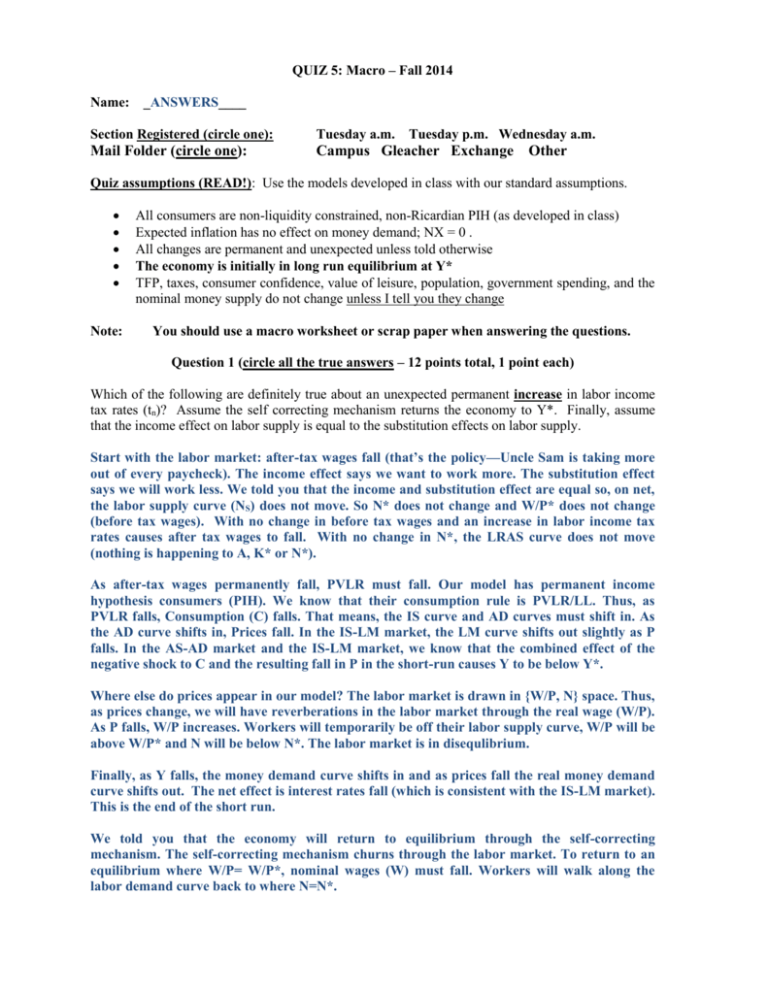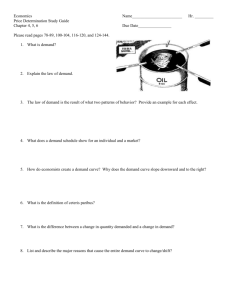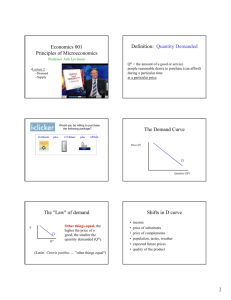Week 9 Practice Quiz a answers
advertisement

QUIZ 5: Macro – Fall 2014
Name: _ANSWERS____
Section Registered (circle one):
Tuesday a.m. Tuesday p.m. Wednesday a.m.
Mail Folder (circle one):
Campus Gleacher Exchange Other
Quiz assumptions (READ!): Use the models developed in class with our standard assumptions.
Note:
All consumers are non-liquidity constrained, non-Ricardian PIH (as developed in class)
Expected inflation has no effect on money demand; NX = 0 .
All changes are permanent and unexpected unless told otherwise
The economy is initially in long run equilibrium at Y*
TFP, taxes, consumer confidence, value of leisure, population, government spending, and the
nominal money supply do not change unless I tell you they change
You should use a macro worksheet or scrap paper when answering the questions.
Question 1 (circle all the true answers – 12 points total, 1 point each)
Which of the following are definitely true about an unexpected permanent increase in labor income
tax rates (tn)? Assume the self correcting mechanism returns the economy to Y*. Finally, assume
that the income effect on labor supply is equal to the substitution effects on labor supply.
Start with the labor market: after-tax wages fall (that’s the policy—Uncle Sam is taking more
out of every paycheck). The income effect says we want to work more. The substitution effect
says we will work less. We told you that the income and substitution effect are equal so, on net,
the labor supply curve (NS) does not move. So N* does not change and W/P* does not change
(before tax wages). With no change in before tax wages and an increase in labor income tax
rates causes after tax wages to fall. With no change in N*, the LRAS curve does not move
(nothing is happening to A, K* or N*).
As after-tax wages permanently fall, PVLR must fall. Our model has permanent income
hypothesis consumers (PIH). We know that their consumption rule is PVLR/LL. Thus, as
PVLR falls, Consumption (C) falls. That means, the IS curve and AD curves must shift in. As
the AD curve shifts in, Prices fall. In the IS-LM market, the LM curve shifts out slightly as P
falls. In the AS-AD market and the IS-LM market, we know that the combined effect of the
negative shock to C and the resulting fall in P in the short-run causes Y to be below Y*.
Where else do prices appear in our model? The labor market is drawn in {W/P, N} space. Thus,
as prices change, we will have reverberations in the labor market through the real wage (W/P).
As P falls, W/P increases. Workers will temporarily be off their labor supply curve, W/P will be
above W/P* and N will be below N*. The labor market is in disequlibrium.
Finally, as Y falls, the money demand curve shifts in and as prices fall the real money demand
curve shifts out. The net effect is interest rates fall (which is consistent with the IS-LM market).
This is the end of the short run.
We told you that the economy will return to equilibrium through the self-correcting
mechanism. The self-correcting mechanism churns through the labor market. To return to an
equilibrium where W/P= W/P*, nominal wages (W) must fall. Workers will walk along the
labor demand curve back to where N=N*.
In the AS-AD market, the nominal wage (W) reflects a major input price. As W falls, the SRAS
curve (firms’ production schedule) will shift out as it becomes cheaper to produce. How far will
the SRAS shift out? It shifts until the AS-AD market is back in equilibrium. As the SRAS curve
shifts out, prices (P) fall further.
As prices fall further, the LM curve (M/P) shifts out further until Y=Y*. As the LM curve shifts
out, interest rates fall further, the interest-rate sensitive component of Investment increases.
Finally, as Y returns to Y*, the money demand curve shifts out to its original level. The money
supply curve shifts out more as prices fall further. Remember, the money supply curve is M/P.
What happens to actual deficits? We define actual deficits as G + Tr – (g + tn)Y. Between the
initial condition and short run, tn increases but Y falls, so it is ambiguous. Between the initial
condition and long-run, nothing happens to Y and tn increases, so actual deficits fall. Between
the short run and long run, Y increases, so actual deficits must fall.
What happens to structural deficits? We define structural deficits as G + Tr – (tn + g)Y*.
Because the income and substitution cancel, nothing happens to N* in this problem, so, nothing
happens to Y*. Thus, we can sign the change in structural deficits based on the policy. The tax
rate is increasing, thus, structural deficits will fall.
.
a.
Interest rates (r) will fall between the short run and the long run. True. This happens as the
LM curve shifts out.
b.
Consumption (C) will increase between the short run and the long run. False. The increase
in Investment (not consumption) returns the economy to equilibrium where Y=Y*.
c.
The money demand curve (MD) will, on net, shift to the right between the short run and the
long run. True. The money demand curve shifts right as Y increases.
d.
The money supply curve (MS) will, on net, shift to the right between the short run and the
long run. True. Fed policy does not change (so M is fixed). However, P falls, so M/P
increases (the money supply curve is M/P)
e.
Actual deficits will fall between the short run and the long run. True. They fall as Y
increases between the SR and LR and tn increases.
f.
Structural deficits will increase between the initial condition and the long run.
They fall as tn increases and Y* is fixed.
g.
The aggregate demand curve (AD) will, on net, shift to the right between the short run and
the long run. False. The AD does not shift between the SR and LR. Relative to the initial
condition, the AD curve is shifted left from the fall in C.
h.
The labor supply curve (Ns) will shift to the right (on net) between the short run and the long
run. False. The income and substitution effects cancel. On net, the labor supply curve
does not shift (in either short run or long run).
i.
The short run aggregate supply curve (SRAS) will be shifted right in the short run (relative to
the initial position). False. The SRAS curve does not move between the initial condition
and short run. Between the short run and long run, the SRAS curve shifts right.
False.
j.
The percentage change in nominal wages (W) between the short and long run will be larger
(in absolute value) than the percentage change in prices (P) between the short and long run.
True. This has to be true for the SCM to return us to equilibrium. Real wages have to
fall.
k.
The long run aggregate supply curve (LRAS) will, on net, shift right between the short and
long run. False. Recall, nothing happens to Y*.
l.
The IS curve will be shifted, on net, to the left in the long run relative to the initial position.
True. The IS curve is shifted left in the short run and stays there between the short run
and the long run. So, the IS curve is shifted left relative to the initial position from the
fall in C.
Question 2 (4 points total—no partial credit: 0 or 4 points)
Which of the following statements are true? For this problem, circle only one of the following
answers. All the quiz assumptions hold for this question (and ALL questions on this quiz).
a. A permanent increase in government spending (G) with the self-correcting mechanism will
cause velocity of money (V) to not change between the initial condition and the long run.
False. Between the initial condition and short run, an increase in G shifts out the IS curve and
AD curve. The shift out of the AD curve causes P to increase. This causes the real wage (W/P) to
fall and N to increase so that N>N*. The economy is in a disequilibrium (workers are off their
labor supply curve). With the self-correcting mechanism, W increases until W/P = W/P* and
N= N*. As W increases, it becomes more expensive for firms to produce, shifting in the SRAS
curve until Y=Y*. As SRAS shifts in, P increases.
Let’s rearrange the velocity of money formula: %∆V = %∆P + %∆Y- %∆M. Between the initial
condition and long run, nothing happens to M (no Fed intervention). Nothing, on net happens to
Y (the economy self-corrects). What happens to P? Between the initial condition and short-run,
P increases as the AD curve shifts out. Between the short run and long run, P increases again as
the SRAS curve shifts in. Thus, as %∆P increases, the velocity of money also increases.
b. A permanent increase in government spending (G) with a Fed that has a policy goal of price
stability (keeping P close to P0) will cause velocity of money (V) to increase between the
initial condition and the long run.
True. Between the initial condition and short run, an increase in G shifts out the IS curve and
AD curve. The shift out of the AD curve causes P to increase. This causes the real wage (W/P) to
fall and N to increase so that N>N*. The economy is in a disequilibrium (workers are off their
labor supply curve). With a price-stabilizing Fed intervention, M contracts shifting in the AD
curve until P=P* and Y=Y*.
Let’s rearrange the velocity of money formula: %∆V = %∆P + %∆Y- %∆M. Between the initial
condition and long run, M falls (that’s the Fed policy). Nothing, on net happens to Y (the
economy returns to equilibrium where P=P* and Y=Y*). Between the initial condition and
short-run, nothing happens to P (the Fed intervention stabilized prices). Thus, as %∆M
decreases, the velocity of money increases.
c. A permanent increase in the nominal money supply (M) with no further Fed intervention will
cause velocity of money (V) to not change between the initial condition and the long run.
True. Between the initial condition and short run, an increase in M shifts out the LM curve and
AD curve. The shift out of the AD curve causes P to increase. This causes the real wage (W/P) to
fall and N to increase so that N>N*. With the self-correcting mechanism, W increases until W/P
= W/P* and N= N*. As W increases, it becomes more expensive for firms to produce, shifting in
the SRAS curve until Y=Y*. As SRAS shifts in, P increases. In the long run, the percentage
change in W will equal the percentage change in P (given that W/P doesn’t change between the
initial condition and the long run). In the long, there is no change in Y. That means there is no
change in I (C and G do not change in this problem). If there is no change in I, there must be
no change in r in the long run (given I(.) didn’t change). Lets go to the money market. In the
long run, there is no change in money demand (because there is no change in Y). If there is no
change in interest rates and no change in money demand, there must not be any change in
money supply. The money supply curve is M/P. That means the percentage change in M must
equal the percentage change in P! (that was a hard question – but, it did come off the practice
quizzes)
Let’s rearrange the velocity of money formula: %∆V = %∆P + %∆Y- %∆M. Between the initial
condition and long run, M increases (from the initial shock from the Fed policy). Nothing, on
net happens to Y (the economy self-corrects). What happens to P? Between the initial condition
and short-run, P increases as the AD curve shifts out. Between the short run and long run, P
increases again as the SRAS curve shifts in. As discussed above, given there was no change in
Y, the % change in P increases must exactly equal the % change in M.
d. Both (a) and (b) are true.
e. Both (a) and (c) are true.
f.
Both (b) and (c) are true.
g. (a), (b) and (c) are true.
g. None of the above are true.
Question 3 (4 points total—no partial credit: 0 or 4 points)
Suppose there is an unexpected increase in consumer confidence. Assume further that there are no
income effects on labor supply.
Lastly, assume the self-correcting mechanism returns us to
equilibrium. Which of the following is true about the economy in the short run. When answering,
compare the initial condition to the short run. Circle only one answer.
Between the initial condition and short run, an increase in consumer confidence causes C to
increase. The increase in C shifts right the IS curve and AD curve. The shift right of the AD
curve causes P to increase. This causes the LM curve to shift left as P increases. However, we
know that Y will be above Y*. (the only reason that P increased was because Y increased) The
increase in P causes the real wage (W/P) to fall and N to increase so that N>N*. The economy is
in a disequilibrium (workers are off their labor supply curve).
a. The IS curve will, on net, shift right, there will be no shift in the LM curve, interest rates (r)
will increase and output (Y) will increase. False. The LM curve shifts in as P increases.
b. The LM curve will, on net, shift right, there will be no shift in the IS curve, interest rates (r)
will fall and output (Y) will increase. So False. The LM curve shifts left as P increases.
The IS curve shifts right as C increases. Interest rates increase as the IS curve shifts
right.
c. The IS curve will, on net, shift right, the LM curve will, on net, shift left, interest rates (r) will
increase and the effect on output (Y) will be ambiguous. False. The effect on output is not
ambiguous. How do we know this? The AD curve is the IS and LM curve compressed
into one curve and drawn in {Y.P} space. As C increases, the AD curve shifts right and
Y is above Y*. Thus, the combined effect of the IS curve shifting right (from the
increase in C) and the LM curve shifting left (from the increase in P) must be Y above
Y*.
d. The IS curve will, on net, shift right, the LM curve, on net, will shift right, output (Y) will
increase and the effect on interest rates (r) will be ambiguous. False. The LM curve shifts
left and the IS curve shifts right both putting upward pressure on interest rates.
e. The IS curve will, on net, shift right, the LM curve will, on net, shift left, interest rates (r) will
increase and output (Y) will increase. True!!!!
f.
The IS curve will, on net, shift right, the LM curve will, on net, shift right, output (Y) will
increase and interest rates (r) will increase. False. The LM curve shifts left as P increases.






